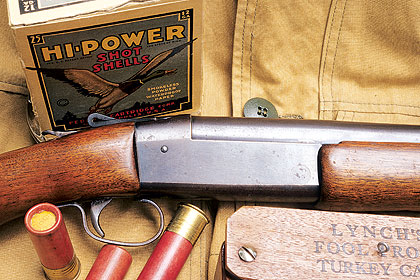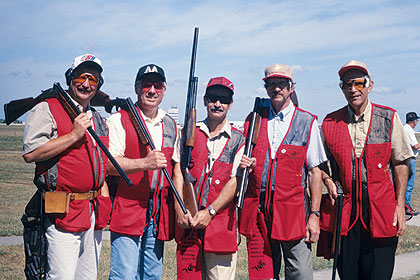This economical shotgun has a lot to offer.
By Layne Simpson
I have no idea how many youngsters start out with single-shot shotguns today but when I was growing up, few kids either expected or got anything else. My cousin Coy's first shotgun was a .410-bore L.C. Smith (and how I used to lust over that little double) but he was an exception.
 For many of us, the single-shot is more fun to hunt with today than during days of yesteryear because now we don't have to. |
Come late December during the year of our 10th birthday, my chums and I all got single-shots and the way we reacted as we excitedly ripped red and green paper from that long package beneath the Christmas tree, you'd have thought the blued-steel beauties we held in our sweaty little hands were made by Westley Richards or Holland & Holland rather than Winchester or Harrington & Richardson.
We would not have been more proud of those guns had they been meticuously hand-made, one by one, in London or Birmingham rather than turned out by the thousands as they actually were on high-speed machinery in New Haven and Bridgeport.
Back then, single-shots (or single-barrels as we and most manufacturers called them) were also available from Iver Johnson, Savage, Stevens and Sears Roebuck; the latter sold under the J.C. Higgins banner. My first shotgun was a .410-bore "Ivy" Johnson and I almost wore the bluing from its shiny barrel by cleaning it at least once each week--even when hunting season was closed.
Single-barrel shotguns were bargains back then and they still are. The Iver Johnson Champion I hunted with during the 1950s sold for $25.50 in 12, 16, 20 or .410. By comparison, the least expensive Winchester Model 12 pump gun had a $93.85 price tag.
 The Winchester Model 37 in 12, 16, 20 or .410 sold for $29.95 during the '50s; this one belonged the author's father-in-law, Barney Link, who was a farmer and an avid rabbit hunter. |
Shop around today and you can buy a New England Pardner in 12, 16, 20, 28 or .410 for around $150 and sometimes less on the used gun market. Winchester no longer makes the Model 12 but the Remington Model 870 Wingmaster pump gun runs around $600. Back in the 1950s the single-barrel cost about 25 percent as much as the best pump gun available and the same still holds true today.
Considering their low prices, some single-shots feel quite nice in the hands and are surprisingly well balanced. This seems to especially hold true for me when the gun is in 20- or 28-gauge. Sometime back I used a 28-gauge Stoeger Hammer-less Hunter while hunting chukar and Hungarian partridge at Pintail Point, a hunting preserve on the Eastern Short of Maryland.
Even though others in our group were shooting over-unders and autoloaders I ended up with just as many birds as anyone else and at the end of the day I had fired fewer shells. Knowing you have only one round on tap between reloads makes you take just enough more time to make that first shot count.
I also hunted bobwhite quail a bit this past season with a Pardner from New England Arms in 28-gauge and I don't mind admitting I shot it so well I decided to keep it. It weighs six pounds and that, along with an overall length of only 251„2 inches, makes it ideal for packing along on big-game hunts where a bit of wingshooting might also be available.
When traveling to Alaska I almost always carry a lightweight 20- or 28-gauge shotgun along and more often than not it pays off. Not long back we missed the caribou migration and while other hunters in our group spent the entire hunt straining their eyeballs for antlers that never appeared on the horizon, I had an exciting time shooting ducks and ptarmigan with my little 28 gauge. Economical single-barrel shotguns are also available from Rossi and from Remington under the Spartan Gunworks banner.
In the hands of someone who knows how to make it sing its sweet song, the single-shooter can be rather quick on the second shot. When I was growing up, two of my favorite hunting pals were brothers. The one who hunted with a single-barrel shotgun could often get off a second shot in the field about as quickly as his brother who carried a bolt-action gun.
 In this photo taken at the Grand American trap shoot, the author (second from left) and two other members of his squad are shooting single-shot guns. |
To this day I can shoot the old single-shot quite rapidly simply because I remember how my friend Forrest did it. Part of the secret (for a right-handed shooter) is to carry a second round between the fingers of the left hand. After the gun is fired, the butt of the stock is lowered and allowed to slip beneath the armpit and as the thumb depresses the top lever, the muzzle of the gun is flipped sharply downward to open the gun. As the ejector sends the smoking hull skyward, the left hand places a fresh round in the chamber and then closes the gun.
The hammer is cocked as the gun is brought back to the shoulder for the second shot.
Everything except placing a fresh shell into the chamber and closing the gun is done with the right hand. And how quick is it? With a bit of practice I can start with the gun lowered and get off two aimed shots inside five seconds. Admittedly, that's not sending lead downrange as fast as is possible with a pump or autoloader, but I sometimes find it to be fast enough to take two quail from a covey when the birds forget to flush in concert.
Not as many different brands and models of single-shot, break-action field guns are manufactured today as there once were but enough are available to keep the idea alive and well. Most are available in 12 and 20 gauge plus the .410 while a few are offered in 16-gauge as well. For those who prefer guns with no external hammer, the Hamerless Hunter from Stoeger I mentioned earlier is worthy of a serious look. The more traditional hammer guns include the Harrington & Richard-son Topper and the Pardner from New England Firearms.
Some are also available with a rifled barrel for shooting slugs. At 100 yards, a 20-gauge H&R Model 92 B Ultra Slug Hunter I recently shot would keep five of Remington's Buckhammer slugs in a group I could cover with one hand.
 The author shot this 28-gauge Pardner so well he decided to keep it. |
Thompson/Center offers a single-shot shotgun on the Encore action in 12 and 20 gauges.
During the 2004 spring season I used one in 20-gauge and Remington ammo loaded with 11„4 ounces of No. 6 Hevi-Shot to take a 24.5-pound gobbler in the hills of Eastern Kentucky. The gun wore an extended choke with .045-inch of construction from Hunter's Specialties.
Last time I looked the least expensive Browning BT-99 Trap was $1300 and the Perazzi MX15 would set you back just over $10,000. Most serious trapshooters use an over-under on doubles and then switch to a single-shot for shooting at handicap distances. I don't shoot much trap anymore but back when I did I used a Remington 90T and I still own that gun.
Spend a few days in the field with a single-shot. I find it much more fun to hunt with now than back when I could afford to hunt with nothing else.
Single-Shots For Clay Targets
Mention of a single-shot shotgun usually brings to mind an inexpensive bunny-harvester carried by a farm boy wearing tattered overalls and a straw hat (which I once was) but some of the guns made during days of yesteryear and today cost more than many repeaters.
In the old days companies such as L.C. Smith and Ithaca built single-barrel shotguns for trap shooting and the same type of gun is offered today by Browning, Beretta, Ljutic, Krieghoff, Blaser, Perazzi and a few others. And they are not cheap.






